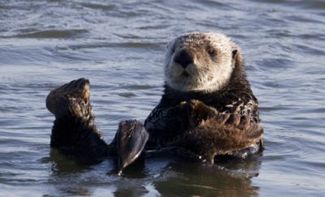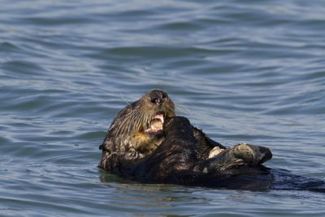Sea Otters at Bay
Air Date: Week of March 4, 2011

Otter Pauses. (Photo: Salt Marsh Diary ©)
Sea otters may be adorable creatures, but not everyone loves them. Fishermen often blame the sea otter for continuing declines in shellfish. Salt Marsh Diary author Mark Seth Lender watched otters at the Elkhorn Slough in Monterey, California. He writes that they are both playful and have a unique and vital niche in nature.
Transcript
GELLERMAN: Well, just down the road from where Dr. Owyang hangs his shingle is the Elkhorn Slough. The nature reserve is a jewel of the California coastline are one of the top biodiversity hotspots in the world and home to a large population of playful sea otters.

A female sea otter eats a clam. (Photo: Salt Marsh Diary ©)
But for fisherman in the area, the otters are anything but fun and games. The furry food competitors can eat a quarter of their weight in shellfish a day. Though, as writer Mark Seth Lender sees it, what otters remove from the sea they more than make up by what they give back.
LENDER: Sea Otter, floating flat on his back, feet straight out at a slightly knock-kneed angle, paws folded on his chest like Charlie Chaplin at his silent best. Rafting together with all the others, he lazes into the hazy morning shift, in sixes and eights, fours and fives and a dozen. Then buoyant as butter, all drift apart. Sea Otter, that fur bundle, soft and wet and lumpy as a bag of spuds.

(Photo: Salt Marsh Diary ©)
As the warmth of the morning paints the bay, otters rub their eyes awake and begin their ablutions. Old boys dignified of demeanor, widely mustachioed under the nose like the off-white foam of an oversized cappuccino. Subadults, a sophomore class not yet mature enough to sport mustaches of their own. Semi-delinquent juveniles, rambunctious, rough-wrestling the peace and quiet into turbulent foam. No one seems to mind - it is not discipline but clean that is Otter’s credo.
Paws scrub and brush with great dexterity. Even behind the ears and in them, legs and backs and bellies, and under the chin. Arms and elbows, noses and the webbing between the toes. Formidable teeth are flossed bright by fingers brushing like toothbrushes. From the back of the neck to those broad hind feet chewed in the mouth like mukluk leather, not a centimeter is neglected.
In water hovering near 40 degrees, even with the thickest coat known to Nature, after a few hours an otter starts to freeze. The need to maintain body heat fuels an otter’s hunger, and throughout the day drives him to dive in forests of green kelp and golden water, there to wrest his dinner from the bottom of the sea.
Sea Otter bobs to the surface with his breakfast. With the most ancient of tools - the anvil stone balanced on his belly and the hammer of his arms - he will part any shellfish from its flesh. Each otter is a specialist, some preferring crabs, others eating only sea urchins. Many take only sea clams, broad as a hat brim, quickly cracked open, chewed and swallowed, then down again for more.
Kelp, the source of all this richness owes its life to Sea Otter. Without him, urchins multiply unrestrained, consuming everything, ruling again where they have not ruled in four hundred million years. Even the kelp disappears, forcing evolution back from where it came. If the otter dies out, the past becomes the present - a time and place in which humanity played no part, transformed into a future you don’t want to know.
[SEA OTTERS CALLING]
GELLERMAN: Mark Seth Lender’s new book Salt Marsh Diary, a collection of his wildlife essays will soon be published by St. Martin’s Press. To see Mark’s photos and video of sea otters at Elkhorn Slough, surf over to our website loe dot org.
Links
Sea Otter Studies at USGS Western Ecological Research Center
Living on Earth wants to hear from you!
Living on Earth
62 Calef Highway, Suite 212
Lee, NH 03861
Telephone: 617-287-4121
E-mail: comments@loe.org
Newsletter [Click here]
Donate to Living on Earth!
Living on Earth is an independent media program and relies entirely on contributions from listeners and institutions supporting public service. Please donate now to preserve an independent environmental voice.
NewsletterLiving on Earth offers a weekly delivery of the show's rundown to your mailbox. Sign up for our newsletter today!
 Sailors For The Sea: Be the change you want to sea.
Sailors For The Sea: Be the change you want to sea.
 The Grantham Foundation for the Protection of the Environment: Committed to protecting and improving the health of the global environment.
The Grantham Foundation for the Protection of the Environment: Committed to protecting and improving the health of the global environment.
 Contribute to Living on Earth and receive, as our gift to you, an archival print of one of Mark Seth Lender's extraordinary wildlife photographs. Follow the link to see Mark's current collection of photographs.
Contribute to Living on Earth and receive, as our gift to you, an archival print of one of Mark Seth Lender's extraordinary wildlife photographs. Follow the link to see Mark's current collection of photographs.
 Buy a signed copy of Mark Seth Lender's book Smeagull the Seagull & support Living on Earth
Buy a signed copy of Mark Seth Lender's book Smeagull the Seagull & support Living on Earth

